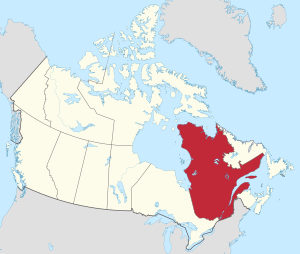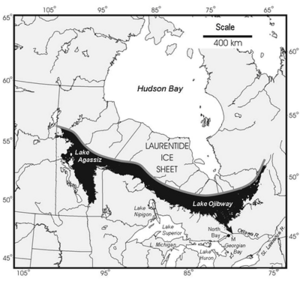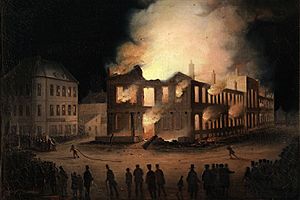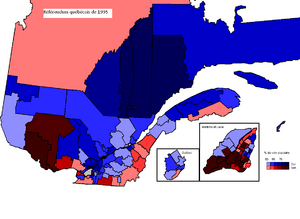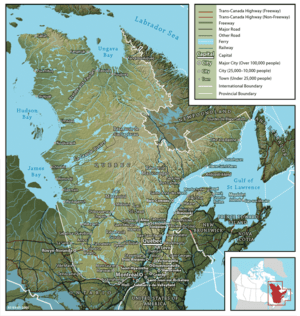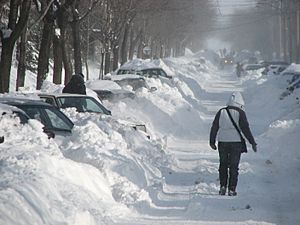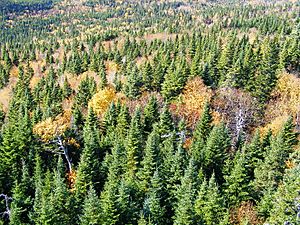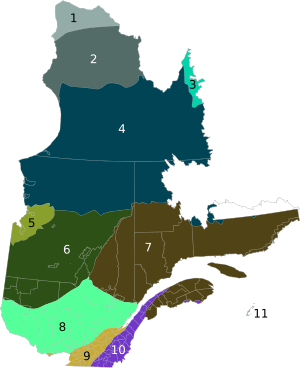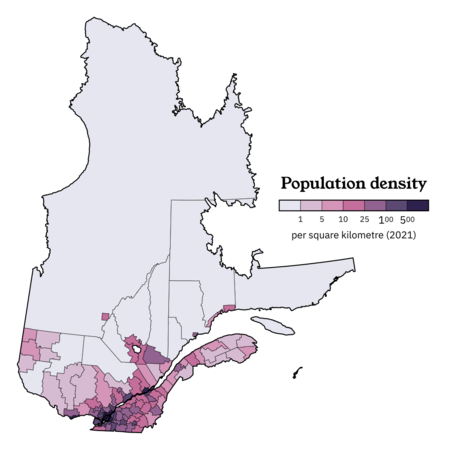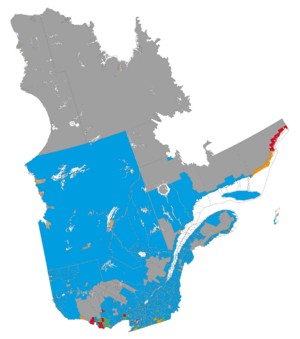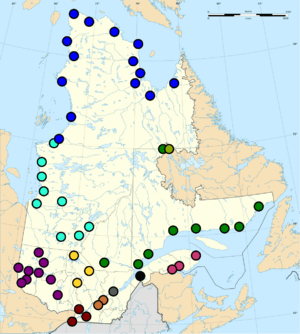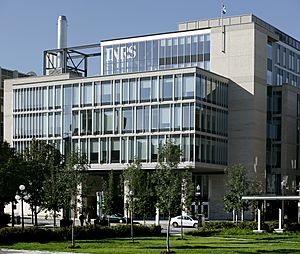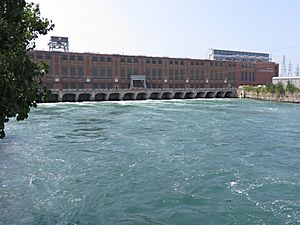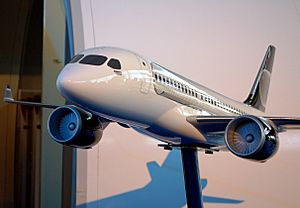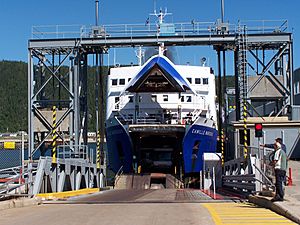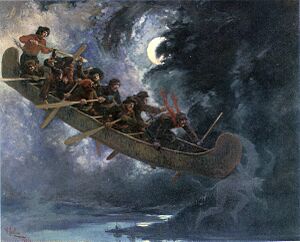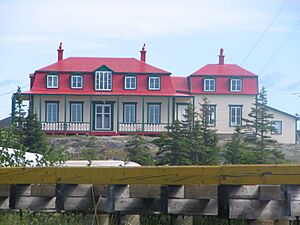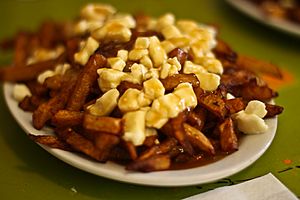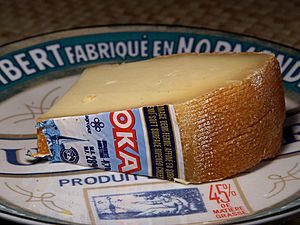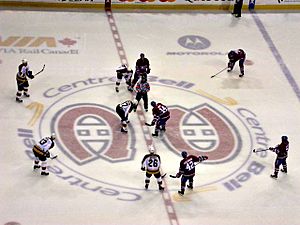Quebec facts for kids
Quick facts for kids
Quebec
Québec (French)
|
|||
|---|---|---|---|
|
|||
| Motto(s): | |||
| Country | Canada | ||
| Confederation | July 1, 1867 (1st, with New Brunswick, Nova Scotia, Ontario) | ||
| Capital | Quebec City | ||
| Largest city | Montreal | ||
| Largest metro | Greater Montreal | ||
| Government | |||
| • Type | Parliamentary constitutional monarchy | ||
| Area | |||
| • Total | 1,542,056 km2 (595,391 sq mi) | ||
| • Land | 1,365,128 km2 (527,079 sq mi) | ||
| • Water | 176,928 km2 (68,312 sq mi) 11.5% | ||
| Area rank | Ranked 2nd | ||
| 15.4% of Canada | |||
| Population
(2021)
|
|||
| • Total | 8,501,833 | ||
| • Estimate
(Q4 2024)
|
9,100,249 | ||
| • Rank | [[Population of Canada by province and territory|Ranked 2nd]] | ||
| • Density | 6.23/km2 (16.1/sq mi) | ||
| Demonym(s) | in English: Quebecer, Quebecker, Québécois in French: Québécois (m), Québécoise (f) |
||
| Official languages | French | ||
| GDP | |||
| • Rank | 2nd | ||
| • Total (2022) | C2.737 billion | ||
| • Per capita | C,651 (9th) | ||
| HDI | |||
| • HDI (2019) | 0.916—Very high ([[List of Canadian provinces and territories by Human Development Index|9th]]) | ||
| Time zone | UTC−05:00 (Eastern Time Zone for most of the province) | ||
| • Summer (DST) | UTC−04:00 | ||
| Postal abbr. |
QC
|
||
| Rankings include all provinces and territories | |||
Quebec is one of Canada's thirteen provinces and territories. It is the largest province by area in Canada. Quebec covers a huge area of about 1.5 million square kilometers. It is located in Central Canada and shares borders with Ontario, Newfoundland and Labrador, and New Brunswick. To the north, it touches James Bay, Hudson Bay, and the Arctic Ocean. To the south, it borders the United States.
Quebec is the second-largest province by population. Most people live in the St. Lawrence River valley. This is where you'll find Montreal, its biggest city, and Quebec City, the capital.
From 1534 to 1763, Quebec was a French colony called Canada. It was the most developed part of New France. After the Seven Years' War, it became a British colony. It was known as the Province of Quebec (1763–1791), then Lower Canada (1791–1841), and later part of the Province of Canada (1841–1867). Quebec joined Canada in 1867, along with Ontario, Nova Scotia, and New Brunswick.
Until the 1960s, the Catholic Church had a big influence on society and culture in Quebec. But the Quiet Revolution in the 1960s changed things. The Government of Quebec took on a bigger role in public life.
Quebec has its own special laws and culture. Its official language is French, and Québécois French is the local way of speaking it. Quebec is the only province where most people speak French. The economy of Quebec relies on its service and industrial sectors. Key industries include aeronautics, hydroelectricity, mining, and pharmaceuticals. Quebec is also famous for maple syrup, comedy, and hockey. It has a rich culture with its own literature, music, and films.
Contents
- Etymology: What's in a Name?
- History: A Journey Through Time
- Indigenous Peoples and Early Explorers
- New France: French Settlers Arrive
- Seven Years' War: British Take Over
- Quebec Act: Protecting French Culture
- American Revolution's Impact
- Patriotes Rebellion in Lower Canada
- Canadian Confederation: Joining Canada
- World Wars and Quiet Revolution
- October Crisis and Referendums
- Special Status for Quebec
- Geography: Land and Water
- Law: How Quebec is Governed
- Demographics: Who Lives in Quebec?
- Economy: How Quebec Makes Money
- Education: Learning in Quebec
- Infrastructure: Getting Around and Staying Healthy
- Culture: The Heart of Quebec
- Emblems of Quebec
- Quebec's Diaspora: People Who Moved Away
- See also
Etymology: What's in a Name?
The name Québec comes from an Algonquin word. It means 'narrow passage' or 'strait'. This name first referred to the area around Quebec City. Here, the Saint Lawrence River becomes very narrow, with cliffs on both sides. French explorer Samuel de Champlain chose the name Québec in 1608 for his new colonial outpost. This outpost became the main center for New France.
History: A Journey Through Time
Indigenous Peoples and Early Explorers
When Europeans first arrived, Algonquian, Iroquois, and Inuit nations lived in what is now Quebec. Their ways of life matched the land. Algonquians were nomadic hunters and fishers in the Canadian Shield. The St. Lawrence Iroquoians grew crops in the fertile St. Lawrence Valley. The Inuit still fish and hunt in the Arctic regions. These groups traded with each other and sometimes fought.
New France: French Settlers Arrive
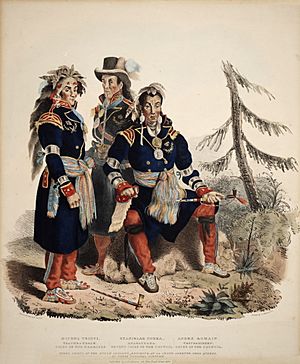
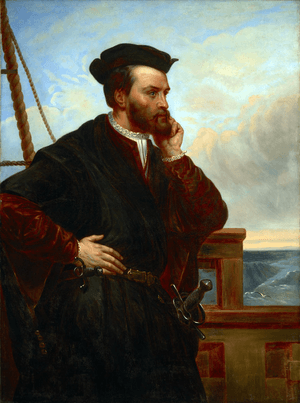
Around 1522, Italian explorer Giovanni da Verrazzano was sent by the King of France to find a western route to China. In 1534, Jacques Cartier placed a cross in the Gaspé Peninsula. He claimed the land for France. This was the start of New France. Early attempts by the French to settle failed. But French fishing boats kept visiting the Atlantic coast and the St. Lawrence River. They made friends with First Nations groups. These friendships became very important later.
In 1608, Samuel de Champlain founded Quebec City. He wanted to make it part of the French colonial empire. Champlain built a fur trading post. Here, he formed trading and military alliances with the Algonquin and Huron nations. First Nations traded furs for French goods like metal tools and guns.
French explorers and missionaries traveled deep into North America. They used river canoes to explore. They set up fur trading forts on the Great Lakes and other major rivers.
In 1627, King Louis XIII of France allowed the Company of New France to bring in the seigneurial system. This system organized land ownership. Only Roman Catholics were allowed to settle in New France.
In 1629, Quebec was taken by English privateers. But Champlain argued it was illegal because the war had ended. The lands were returned to France in 1632. New France became a Royal Province in 1663 under King Louis XIV of France. The population grew slowly, mostly from births, not immigration. To help the population grow, King Louis XIV sent about 800 young French women, called les filles du roi, to the colony. Most French settlers were farmers, known as "Habitants".
Seven Years' War: British Take Over
French authorities tried to remove British traders from the Ohio Valley. They built forts to protect the area. In 1754, George Washington attacked French soldiers. This event led to the French and Indian War in North America. By 1756, France and Britain were fighting the Seven Years' War around the world.
On September 13, 1759, British forces led by General James Wolfe defeated the French. This happened on the Plains of Abraham outside Quebec City. France lost almost all its North American lands to Great Britain in the Treaty of Paris (1763). The Royal Proclamation of 1763 renamed Canada as the Province of Quebec.
Quebec Act: Protecting French Culture
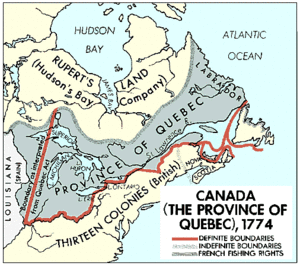
The British worried that French-speaking Canadians might join the growing American Revolution. French-speaking Canadians made up most of Quebec's population. To gain their loyalty, the British passed the Quebec Act in 1774.
The Quebec Act gave people in Quebec their first Charter of Rights. It recognized the French language and culture. It also allowed French civil law to continue. It gave freedom of religion, letting the Roman Catholic Church remain. This was one of the first times a government allowed religious freedom.
American Revolution's Impact
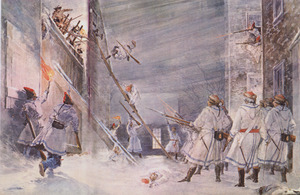
The Quebec Act angered British colonists to the south. They feared it was part of a plan to punish them. In 1775, General George Washington tried to invade Canada. He wanted to take Quebec from the British. The invasion failed. The American army withdrew in 1776.
After the American Revolution, about 10,000 Loyalists moved to Quebec. These were people loyal to the British Crown. They wanted to use the British legal system. To keep peace, Governor Haldimand offered Loyalists free land north of Lake Ontario. This was meant to keep French and English speakers separate. In 1791, the Province of Quebec was divided. This created Lower Canada (mostly French-speaking) and Upper Canada (mostly English-speaking). Each had its own government.
Patriotes Rebellion in Lower Canada
In 1837, people in Lower Canada rebelled. They were led by Louis-Joseph Papineau and Robert Nelson. They wanted to end the British governors' control. They declared equal rights for all citizens and independence for Lower Canada. The British Army defeated the rebels.
After the rebellions, the British government merged the two provinces. In 1840, Lower and Upper Canada became the Province of Canada. But they still had separate administrations and laws. In 1848, the French language regained its legal status in the government.
Canadian Confederation: Joining Canada
In the 1860s, leaders from British North American colonies met. They discussed forming a new country. The Quebec Conference in Quebec City was a key meeting. In 1867, the Parliament of the United Kingdom passed the British North America Acts. This created the Dominion of Canada. The former Province of Canada was split into Ontario and Quebec. New Brunswick and Nova Scotia also joined. Other provinces joined later, like Manitoba in 1870 and British Columbia in 1871.
World Wars and Quiet Revolution
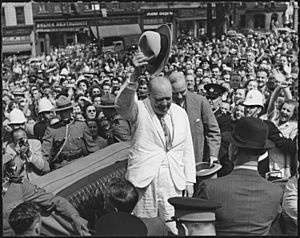
When Great Britain declared war in 1914, Canada automatically joined. About 6,000 Quebec volunteers fought in Europe. But the idea of forcing people to join the army, called conscription, was very unpopular in Quebec. This caused tension between French and English-speaking Canadians.
During World War II, Quebec's participation was bigger. But it also led to another conscription crisis in 1944. Many French-speaking regiments fought against the Axis powers.
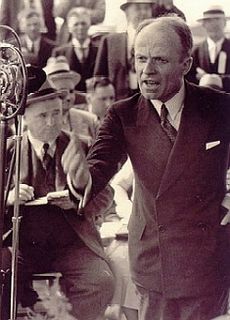
The Quiet Revolution was a time of big social and political change in Quebec. It happened from the 1960s to the 1980s. The influence of the Roman Catholic Church decreased. New hydroelectric companies were formed under Hydro-Québec. A movement for Quebec to become independent grew stronger.
October Crisis and Referendums
In 1970, a group called the Front de libération du Québec (FLQ) kidnapped two officials. One was a British trade commissioner, James Cross. The other was a provincial minister, Pierre Laporte, who was later found dead. This event was called the October Crisis. The Premier of Quebec asked Prime Minister Pierre Trudeau for help. The government used the War Measures Act to restore order.
In 1977, the Parti Québécois government passed the Charter of the French Language, also known as Bill 101. This law made French the only official language of Quebec in areas controlled by the province.
In 1980, Quebec held a referendum on "sovereignty-association." This meant Quebec would be independent but share some things with Canada, like money. Sixty percent of Quebec voters said no. In 1995, a second referendum on sovereignty was held. This time, it was very close, with 50.6 percent voting no and 49.4 percent voting yes.
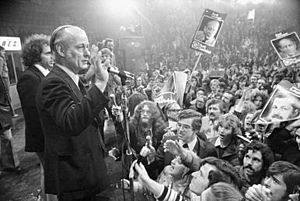
Special Status for Quebec
Because of its unique French heritage, there's been talk about Quebec having a "special status" within Canada. Attempts to change the Canadian constitution to call Quebec a "distinct society" have not succeeded. However, the federal government has recognized Quebec as a distinct society.
In 2006, the House of Commons passed a motion. It stated that "the Québécois form a nation within a united Canada." What this means is still debated.
Geography: Land and Water
Quebec is in eastern Canada. It is a huge province, almost three times the size of France. Most of it is very empty. The land changes a lot from one region to another. The two main areas are the Saint Lawrence Lowlands (south) and the Canadian Shield (north). They are very different.
Waterways: Rivers and Lakes
Quebec has one of the world's largest supplies of fresh water. Water covers 12% of its surface. It has over half a million lakes and 4,500 rivers. These waters flow into the Atlantic Ocean and the Arctic Ocean. The largest man-made lake is the Caniapiscau Reservoir. It was made for hydroelectric power. Lake Mistassini is Quebec's largest natural lake.
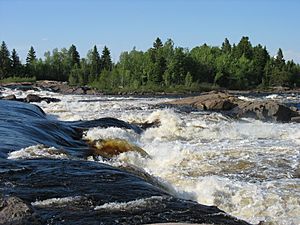
The Saint Lawrence River is very important. It has big ports in Montreal, Trois-Rivières, and Quebec City. This river helped early French explorers and settlers. Since 1959, the Saint Lawrence Seaway connects the Atlantic Ocean to the Great Lakes. Northeast of Quebec City, the river widens into a huge estuary. Many whales, fish, and seabirds live here.
Land Features: Mountains and Plains
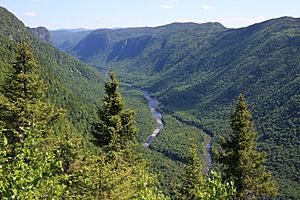
Quebec's highest point is Mont d'Iberville (also called Mount Caubvick). It is 1,652 meters tall. This mountain is on the border with Newfoundland and Labrador.
The most populated area is the Saint Lawrence Lowlands. This flat, low-lying region runs along the Saint Lawrence River. It is bordered by the Laurentian Mountains to the north and the Appalachians to the south. This valley has rich, fertile soil. It is Quebec's best farming area. Mixed forests here produce most of Canada's maple syrup.
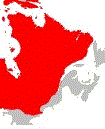
More than 95% of Quebec is covered by the Canadian Shield. This is a flat, rocky, and sometimes mountainous area. It has many lakes, bogs, and rivers. The Canadian Shield is rich in forests, minerals, and hydroelectric resources. These are very important for Quebec's economy.
The Appalachian region is a narrow strip of old mountains. It runs along Quebec's southeastern border. In the Gaspé Peninsula, the Appalachian peaks are over 1,000 meters high.
Climate: Four Seasons
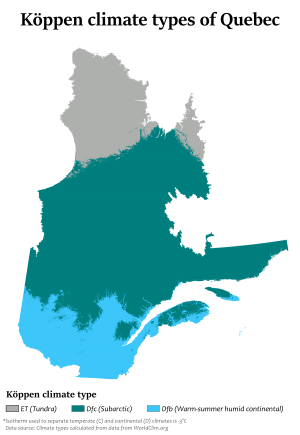
Quebec has three main climate regions. Southern Quebec has a humid continental climate. It has four clear seasons: warm, humid summers and very cold, snowy winters. There is a lot of rain and snow all year. Central Quebec has a subarctic climate. Winters are long, very cold, and snowy. Summers are warm but short. Northern Quebec has an arctic climate. Winters are very cold, and summers are short and cool.
The four seasons in Quebec are spring, summer, autumn, and winter. They differ based on sunlight, temperature, and snow or rain.
In Quebec City, the sun shines for about 8.5 hours in December. In June, it shines for almost 16 hours. In the far north, the difference is even bigger. You can also see the Northern Lights there.
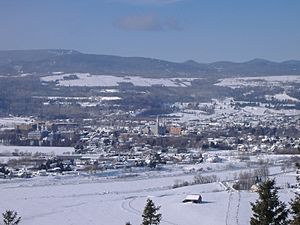
Temperatures vary across Quebec. In summer, average temperatures range from 5°C to 25°C. In winter, they range from -10°C to -25°C. During very hot or cold periods, temperatures can reach 35°C in summer and -40°C in winter.
| Location | July (°C) | January (°C) |
|---|---|---|
| Montreal | 26/16 | −5/−14 |
| Gatineau | 26/15 | −6/−15 |
| Quebec City | 25/13 | −8/−18 |
| Trois-Rivières | 25/14 | −7/−17 |
| Sherbrooke | 24/11 | −6/−18 |
| Saguenay | 24/12 | −10/−21 |
| Matagami | 23/9 | −13/−26 |
| Kuujjuaq | 17/6 | −20/−29 |
| Inukjuak | 13/5 | −21/−28 |
Wildlife: Animals of Quebec
Quebec is home to many animals. Large land animals include the white-tailed deer, moose, muskox, caribou, black bear, and polar bear. Medium-sized animals are the cougar, coyote, eastern wolf, and Arctic fox. Smaller animals often seen are the grey squirrel, snowshoe hare, groundhog, skunk, raccoon, and beaver.
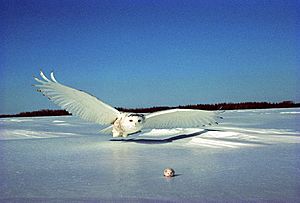
The Saint Lawrence River estuary is home to many marine mammals. These include the blue whale, beluga, minke whale, and harp seal. In the far north, you can find walruses and narwhals.
Quebec's fresh waters have fish like largemouth bass, walleye, Atlantic cod, and Atlantic salmon. Common birds in southern Quebec include the American robin, blue jay, and American crow. Birds of prey like the golden eagle and snowy owl also live here. Sea birds include the Canada goose and Atlantic puffin.
Some farm animals are special to Quebec. These are the Canadian horse, Chantecler chicken, and Canadian cow.
Vegetation: Forests and Plants
Quebec has several large areas of different plants and trees. These areas go from north to south: tundra, taiga, boreal forest, mixed forest, and deciduous forest.
In the far north, near Ungava Bay, is the tundra. Here, only low plants like lichen grow. The tundra covers over 24% of Quebec. South of the tundra is the taiga. It has more plant and animal species. The taiga covers about 20% of Quebec.
The boreal forest is the largest forest area. It covers 27% of Quebec. It has many conifers like spruce and fir trees. The mixed forest is a transition zone. It has a mix of boreal and deciduous trees. This area has many plant and animal species. It covers 11.5% of Quebec.
The deciduous forest is in the warmest part of Quebec. It has the most diverse species, including over 1,600 types of plants. This area has fertile soil and is where most of Quebec's population lives. It covers about 6.6% of Quebec.
Quebec's total forest area is about 750,300 square kilometers. The northern forests have mostly conifers. The southern forests have deciduous trees like sugar maple and red maple.
Law: How Quebec is Governed
Quebec's laws are a mix of federal and provincial rules. The federal government handles criminal law and trade. The provincial government handles private law, justice, healthcare, and education.
Quebec's private law is based on a civil-law system. This is different from the common-law system used in the rest of Canada. Public law in Quebec uses the common-law system. Quebec has its own Quebec Charter of Human Rights and Freedoms.
Both English and French can be used in Quebec's National Assembly and courts.
Courts and Justice
Quebec has a system of courts. At the bottom are municipal courts and special tribunals. Above them are the Court of Quebec and the Superior Court of Quebec. The Court of Quebec handles criminal cases and small civil claims. The Superior Court handles all kinds of cases. Decisions from these courts can be appealed to the Quebec Court of Appeal. The highest court is the Supreme Court of Canada.
Law Enforcement
The Sûreté du Québec is Quebec's main police force. It also helps other police forces, like municipal police. The Royal Canadian Mounted Police (RCMP) enforces some federal laws in Quebec.
Many cities have their own police forces, like Montreal and Quebec City. In smaller towns, the Sûreté du Québec acts as the local police. Indigenous communities in Quebec also have their own police forces.
The Director of Criminal and Penal Prosecutions handles criminal cases in court. Quebec also runs its own prison system for shorter sentences.
Demographics: Who Lives in Quebec?
In 2021, Quebec had a population of about 8.5 million people. This is about 23% of Canada's population. The most populated cities are Montreal, Quebec City, Laval, and Gatineau.
In 2016, the average age in Quebec was 41.2 years. In 2019, Quebec had more births than the year before. The average life expectancy in 2020 was 82.3 years. Quebec's population grew a lot in 2019, mostly due to new immigrants. Many immigrants came from China, India, or France.
Religion in Quebec
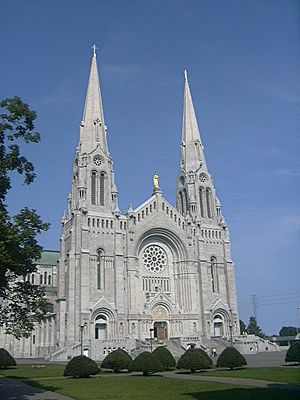
The Roman Catholic Church has been very important in Quebec's history. In 2011, about 75% of Quebec's population identified as Catholic. Other religions include Protestant, Orthodox Christian, Muslim, Jewish, Buddhist, Hindu, and Sikh. About 5.8% of people said they had no religious affiliation.
The oldest parish church in North America is the Cathedral-Basilica of Notre-Dame de Québec. It was finished in 1664. The Basilica of Sainte-Anne-de-Beaupré welcomes millions of visitors each year. Saint Joseph's Oratory is the largest place of worship in the world dedicated to Saint Joseph.
Language: French is Key
Quebec is unique in Canada because French is its only official language. In other Canadian provinces, English is the main language. French is spoken and understood by almost 95% of the population. Quebec is the only Canadian province where most people speak French. About 78% of people said French was their first language in 2011.
Many Quebec residents can speak both French and English. About 42.6% of the population knows both languages. This is the highest percentage in any Canadian province.
Québécois French is the most common way French is spoken here. The Office québécois de la langue française helps protect and promote the French language.
About 8% of Quebec's population (around 650,000 people) have English as their mother tongue. These English speakers, sometimes called Anglo-Québécois, mostly live in Montreal and the Pontiac region.
Quebec also has three families of Indigenous languages. These include Abenaki, Algonquin, Cree, Innu-aimun, Mohawk, and Inuktitut. Many Indigenous languages are passed down well from one generation to the next.
Common immigrant languages in Quebec include Arabic, Spanish, and Italian.
Indigenous Peoples of Quebec
In 2021, about 205,010 Indigenous people lived in Quebec. This includes Inuit, First Nations people, and Métis. The Inuit mostly live in Nunavik in northern Quebec.
There are ten First Nations groups in Quebec: the Abenaki, Algonquin, Attikamek, Cree, Wolastoqiyik, Mi'kmaq, Innu, Naskapis, Huron-Wendat, and Mohawks. The Indian Act created reserves for First Nations. In 1975, the Cree, Inuit, and Quebec government signed an agreement. This agreement extended Indigenous rights beyond reserves.
Acadians in Quebec
Many people in Quebec have Acadian ancestors. Over a million people in Quebec are of Acadian descent. This is because many Acadians fled to Quebec during the Great Upheaval.
Acadian communities mainly live on the Magdalen Islands and in Gaspesia. But there are about thirty other communities elsewhere in Quebec.
Economy: How Quebec Makes Money
Quebec has a modern, market-based economy. In 2022, its gross domestic product (GDP) was about US$50,000 per person. Quebec's economy is the 46th largest in the world. It makes up 19% of Canada's GDP.
Like most developed countries, Quebec's economy relies mostly on the services sector. Quebec also has many natural resources and good infrastructure. The knowledge sector, which includes research and technology, is growing fast. Quebec spends a lot on research and development (R&D). This is higher than the average for many other countries.
Some important companies from Quebec include Bombardier, Desjardins, and Hydro-Québec.
Exports and Imports: Trading with the World
Quebec trades a lot with other countries. This helps its economy. The North American Free Trade Agreement (NAFTA) is very helpful. It gives Quebec access to a large market of consumers in North America.
In 2008, Quebec's exports to other Canadian provinces and abroad were C$157.3 billion. Most of these exports went to the United States (72.2%). Quebec also imports many goods and services. Most imports came from the United States (31.1%) and Europe (28.7%).
Primary Sector: Natural Resources
Quebec produces most of Canada's hydroelectricity. It is the second-biggest hydroelectricity producer in the world. In 2019, 95% of Quebec's electricity came from hydroelectric power stations. The public company Hydro-Québec manages electricity production and distribution. Quebec uses a lot of renewable energy.
Quebec is also a top place for mining. In 2011, the mining industry made up 6.3% of Quebec's GDP. It employed about 50,000 people. Main minerals are gold, iron, copper, and zinc. Quebec is also a source of diamonds.
The agri-food industry is important too. Meat and dairy products are the main parts. This industry creates many jobs and contributes a lot to Quebec's economy.
Secondary Sector: Manufacturing and Industry
Quebec's aerospace industry is very strong. In 2021, it employed 35,000 people. Many aerospace companies like Bombardier and Pratt & Whitney Canada are here. Montreal is a major center for the aerospace industry worldwide.
The pulp and paper industry is also important. It uses wood from Quebec's forests. This industry provides many jobs, especially in smaller towns.
Quebec produces 90% of Canadian aluminum. It is the world's fourth-largest aluminum producer. Three companies make aluminum here. Their nine plants produce 2.9 million tons of aluminum each year.
Tertiary Sector: Services and Technology
The finance and insurance sector employs over 168,000 people. Many banks, like the National Bank of Canada and Desjardins, are based in Quebec.
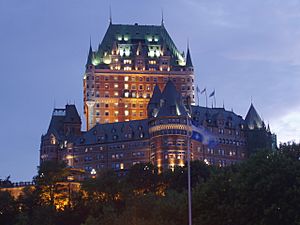
The tourism industry is a big part of Quebec's economy. Quebec is the second most important province for tourism in Canada. It employs over 400,000 people. Most tourism businesses are in or near Montreal and Quebec City. Tourists spend over $6.7 billion in Quebec each year.
Quebec's IT sector has many businesses and jobs. Key areas include telecommunications, multimedia, and video games. Many video game companies like Ubisoft and Electronic Arts are in Quebec.
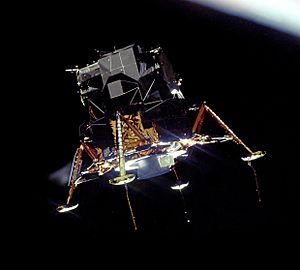
About 1.1 million Quebecers work in science and technology. Quebec is a world leader in scientific research. It has produced ten Nobel laureates in science. It is also a leader in aerospace, IT, and biotechnology. The Canadian Space Agency is located in Quebec. Quebec has contributed to important space discoveries and Canadian artificial satellites.
Quebec is also a world leader in life science. Many important discoveries in medicine and neuroscience were made here. Quebec has over 450 biotechnology and pharmaceutical companies.
Education: Learning in Quebec
Quebec's education system is different from other Canadian provinces. It has five levels: preschool, primary school, secondary school, CEGEP (a type of college), and university. You can also find professional development and adult classes. There are public schools (funded by taxes) and private schools (paid for by students).
All universities in Quebec are public. They get most of their money from taxes. They have more freedom than other levels of education.
Infrastructure: Getting Around and Staying Healthy
Transportation: Roads, Rails, and Air
Transports Québec manages land transportation. The Canadian Coast Guard and Nav Canada handle sea and air travel.
Quebec's road network has about 185,000 kilometers of highways and roads. It also has almost 12,000 bridges and tunnels.
The Saint Lawrence River has eight deep-water ports for shipping goods. Quebec also has 6,678 kilometers of railways. These are mainly for transporting goods. But Via Rail Canada and Amtrak also use them for passengers.
Quebec has 43 airports with daily flights. The government also owns airports and heliports to help people in northern regions. Other transport networks include hiking trails, snowmobile trails, and bike paths. The Green Road is the largest bike path, almost 4,000 kilometers long.
Healthcare: Staying Healthy
Quebec has a public healthcare system. This means the government is the main insurer. Funding comes from taxes. Everyone can get care, no matter their income.
Health and social services are managed together. There are 34 health establishments in Quebec. These include about 140 hospitals. There are also local community service centers (CLSC) and long-term care centers (CHSLD). Private clinics and pharmacies also exist.
Housing: Where People Live
In 2021, about 59.9% of Quebec residents owned their homes. Among homeowners, most were couples with or without children. Among renters, most lived alone.
The average price of a single-family home has increased a lot since the 1980s. It has doubled every 10 years. This means homes are much more expensive than they were 40 years ago. Some cities in Quebec have very few available homes for rent.
Culture: The Heart of Quebec
Quebec has a unique culture. It comes from its French roots and its position as a French-speaking nation surrounded by English speakers.
The Latin Quarter in Montreal and Old Quebec in Quebec City are cultural centers. Cafes and outdoor terraces show a Latin influence. Theatres like the théâtre Saint-Denis are popular attractions.
Many organizations support culture in Quebec. The Conseil des arts et des lettres du Québec (CALQ) helps artists. The Société de développement des entreprises culturelles (SODEC) promotes and funds cultural businesses. The Prix du Québec are awards for great achievements in culture.
Performing Arts: Music, Dance, and More
Traditional music in Quebec often includes dances like the jig and quadrille. Instruments include the fiddle and accordion. First Nations and Inuit also have their own traditional music. Famous Quebec singers include Céline Dion. The Association québécoise de l'industrie du disque, du spectacle et de la vidéo (ADISQ) promotes the music industry.
Quebec has symphony orchestras in Quebec City and Montreal. There are also important contemporary dance troupes. Theatre troupes perform in cultural centers across Quebec. The National Theatre School of Canada trains future actors.
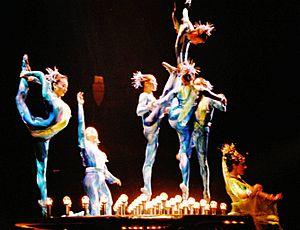
Several circus troupes started in Quebec. The most famous is the Cirque du Soleil. Other troupes include Les 7 Doigts de la Main and Cirque Éloize. The National Circus School trains circus artists.
Comedy is a big part of Quebec culture. Quebec hosts several comedy festivals, like Just for Laughs in Montreal. The National School of Humour trains new comedians.
Media: Film and TV
The Cinémathèque québécoise promotes Quebec's film and TV history. The National Film Board of Canada (NFB) does the same for all of Canada. Many movie theaters show Quebec films. Montreal is a major city for filming movies and TV shows.
Popular Quebec TV shows include La petite vie and Les Bougon. There are also many comedy and cartoon shows for children, like Caillou and Passe-Partout.
In literature, the Québec Édition group helps promote French-language books from Quebec around the world.
Literature and Folklore: Stories and Legends
Quebec's French-speaking people have many folktales. Early settlers brought stories from France and adapted them. Many stories were passed down by raconteurs, or storytellers. These tales often involve the Devil or other supernatural elements. Famous legends include the Chasse-galerie and the Corriveau.
Quebec literature started with explorers' travel accounts. Many famous Quebec poets and authors have shaped its history. Popular writers include Michel Tremblay and Gabrielle Roy. There is also a special type of regional novel called Terroir novel.
Art and Architecture: Buildings and Beauty
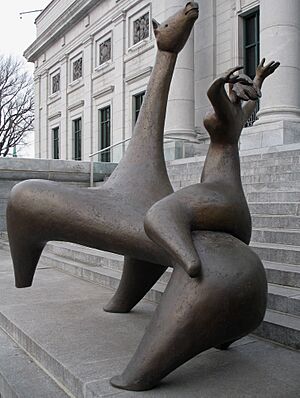
Quebec's art shows its unique landscapes and culture. Famous artists like Jean Paul Lemieux and Jean-Paul Riopelle have created masterpieces. You can see Quebec's fine arts at the Quebec National Museum of Fine Arts and the Montreal Museum of Fine Arts.
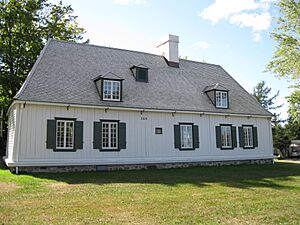
Quebec's architecture is special. It has unique Canadien-style buildings. These are rectangular, one-story houses with very tall, steep roofs. You can also see many other styles, like Classical, Neo-Gothic, and Victorian.
Heritage: Preserving the Past
Many historical sites and works show Quebec's cultural heritage. These include the Village Québécois d'Antan and Fort Chambly. As of 2011, Quebec has 198 National Historic Sites of Canada.
Various museums tell Quebec's cultural history. These include the Museum of Civilization and the McCord Museum. They display artifacts and paintings from Quebec's past.
Cuisine: Delicious Food and Drink
Quebec's traditional food comes from its history. Many dishes are rich and hearty. It has strong French and Irish influences. It also has parts of Canadian Indigenous cuisine. Quebec is famous for its Tourtière (meat pie), Pâté Chinois (shepherd's pie), and Poutine (fries with cheese curds and gravy).
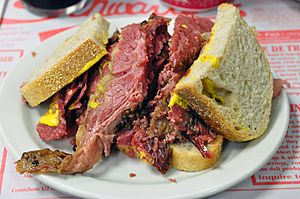
The temps des sucres (sugar season) is an old Quebec tradition. In spring, many Quebecers visit a cabane à sucre (sugar house) for a traditional meal. Montreal's Jewish community added Montreal-style bagels and smoked meat to Quebec's food scene.
Quebec has made beer for centuries. Today, there are many breweries, including Unibroue and Molson Coors. Quebec also produces wine, ice wine, and ice cider.
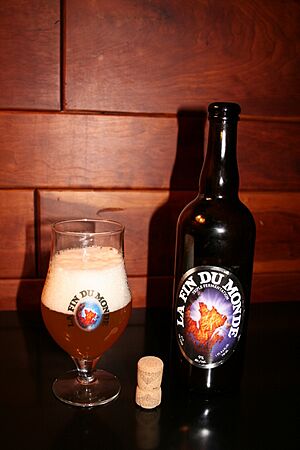
Quebec has also made cheese for centuries. The first cheese-making school in North America opened in 1893. Today, Quebec produces over 300 different cheeses.
Sports: Hockey and More
Sports are a big part of Quebec culture. Ice hockey is the national sport. It was first played in Montreal in 1875. The Montreal Canadiens are a famous hockey team. Other major sports include Canadian football with the Montreal Alouettes and soccer with Club de Foot Montréal. Quebec also hosts the Canadian Grand Prix Formula 1 race.
Quebec athletes have done very well at the Winter Olympics. They won many medals for Canada in recent years.
Holidays and Symbols: Celebrating Quebec
St-Jean-Baptiste Day is one of Quebec's biggest holidays. On June 24, Quebec celebrates its National Holiday. This day honors John the Baptist, the patron saint of French Canada. The song "Gens du pays" is often heard.
National Patriots' Day is another special holiday. It honors the patriotes who fought for change. People display the patriote flag and have ceremonies. Moving Day is a tradition where many people move homes on July 1.
Other traditions include the Réveillon, a big feast on Christmas Eve and New Year's Eve. April Fools' Day is called Poisson d'Avril ("April's Fish"). People play pranks and stick fish-shaped papers on backs.
Quebec has its own coat of arms. It shows French, British, and Canadian history. The motto "Je me souviens" ("I remember") is on the coat of arms. It has been on license plates since 1978. The fleur-de-lis is a common symbol of Quebec. It is an old symbol of the French monarchy.
Quebec's current flag, the Fleurdelisé, was inspired by older French flags. It replaced the Union Jack on Quebec's Parliament Building in 1948.
Emblems of Quebec
Quebec has three official emblems:
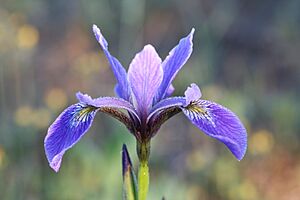
- Iris versicolor Linné. — Iris versicolore. — This is the floral emblem of Quebec since 1999. Its colorful flower shows Quebec's cultural diversity. It also highlights the importance of water.
- Bubo scandiacus. — Harfang des neiges. — This is the avian (bird) emblem of Quebec since 1987. The owl symbolizes Quebec's white winters and its northern climate.
- Betula alleghaniensis Britton. — Bouleau des Alléghanys. — Merisier. — This is the forest emblem since 1993. The yellow birch is a well-known tree in Quebec. It is used in many ways and is valuable. It shows how important forests are to Quebecers.
Quebec's Diaspora: People Who Moved Away
Many French Canadians from Quebec moved to the Canadian prairies long ago. Today, many people in Alberta, Saskatchewan, and Manitoba are their descendants.
From the mid-1800s to the Great Depression, about 900,000 people left Quebec for New England in the United States. They often created "Little Canadas" in industrial towns. About half of them returned to Quebec. Most of those who stayed have blended into American culture.
Some people tried to get Quebecers to move north within Quebec. This led to new regions being founded, like Saguenay-Lac-St-Jean. It also led to communities in Northeastern Ontario. Today, many Franco-Ontarians in places like Timmins are descendants of Quebecers who moved there for mining jobs.
More recently, some Quebecers, called "snowbirds," travel to southern Florida during the winter. This has created temporary "Québécois regions" there.
|
See also
 In Spanish: Quebec para niños
In Spanish: Quebec para niños




